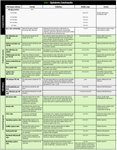Benchmarking: Having good information is the key to making good business decisions
A doctor-owner needs timely and accurate information about business activity in his or her practice. The doctor-owner must capture and incorporate those data to effectively implement improvements in the practice.

Key Points

As a practice management consultant, I often hear, "I went to school to take care of patients." Although taking care of patients undoubtedly is the most important job of a doctor-owner, the ability to make good business decisions certainly is a close second. Good business decisions allow your practice to survive and thrive, even when faced with the tough current economic environment. Good information is the key to making good business decisions.
Gathering information
• Patient visits (usually by procedure code).
• Revenues (collections) broken down by profit center (for instance, optical, contact lenses, exams).
• Expenses (by category).
• Staff hours.
• Full-time equivalent doctors.
• Accounts receivable status broken into aging "buckets."
• Number of clinic sessions.
From this information, the doctor-owner can track trends and use formulas for meaningful management ratios and to develop a customized report called, variously, a flash report, dashboard report, or scorecard report. The reason for creating a single-page summary report is to be able to easily monitor the pulse of a practice. Separate reports can be created for the different profit centers in the business.
Establish standards
Many industries use benchmarking data to compare the efficiency of a company with other businesses in the industry. The most important step in beginning to benchmark, however, is to establish standards within your own practice. From there, the practice sets goals and measures its own progress-competing against yourself, in a sense.
The goal with internal benchmarks is to achieve continuous growth and improvement. The key is to set clear definitions and consistency in the reporting-comparing apples with apples. Also, the doctor-owner must determine which ratios are most important for the type of business. For example, trying to increase the medical management model requires increased exam slots and more "short" appointments. Therefore, as new schedules and programs are implemented for medical management, the forecast for the patients per sessions (or patients per hour) would steadily increase.
Figure 1 shows common benchmarks, definitions, and healthy ranges. This is only a starting point and is not intended as a comprehensive listing. The benchmarks are derived from formal and informal tracking of practice trends by BSM Consulting and other optometric consultant partners. BSM also used industry sources (for example, the American Optometric Association's State of the Profession, and the Management & Business Academy's Key Metrics of Optometric Practice) to corroborate and validate these measures. Optometry currently does not have an independent, formalized database that gathers and reports on optometric benchmarking standards. Vendor sponsors and optical publications, however, have gathered useful information that also is available for determining healthy ranges.
Continuous improvement
Implementing consistent reports and measures is the first step to enhancing your business. Most of us have heard the adage, "What gets measured gets done." By simply creating awareness around significant ratios, such as the cost-of-goods-sold ratio, owners and staff will begin to monitor their activities more closely. Truly successful practices take an additional step and use that information to develop strategic plans and make better business decisions, propelling them to greater success.
Most quality improvement experts will tell you that in any successful effort to make improvements, there is a continuous circle: plan, do, check, act. Benchmarking or dashboard reporting allow a practice to create a baseline or initial measure and then fulfill the ongoing "check" step.
Four steps, when carefully applied and repeated in a cycle of continuous improvement, will help a practice make significant, positive changes:
• First, management and ownership must agree on realistic goals for the practice. To set realistic goals, you first must have a baseline measure.
• Second, accurate and timely information must be gathered. Reliance on faulty data inevitably will result in faulty decisions.
• Third, the information assembled must be analyzed, and a diagnosis of the practice's most critical needs for improvement developed. This diagnosis should include a plan for actions the practice will implement to advance toward its goals. State specifically what needs to be done, who is responsible for completion of the tasks, and a target deadline.
• Fourth, the action steps identified in the plan must be pursued vigorously and tenaciously.
Execution of a plan truly is the only way to purposefully move your practice in a direction you would like to see it take. Without planning and followthrough, you leave others or external forces to dictate your path.
Maureen Waddle is a senior consultant with BSM Consulting, a national health-care-consulting firm. She may be contacted at mwaddle@bsmconsulting.com
.